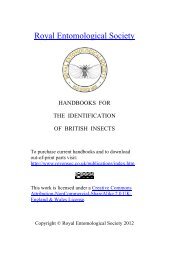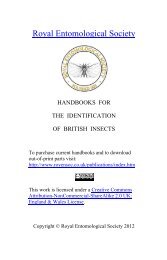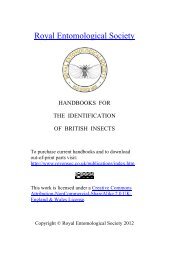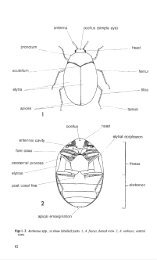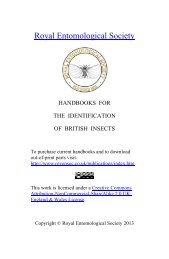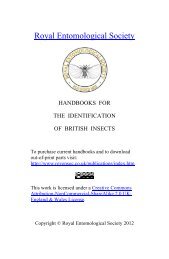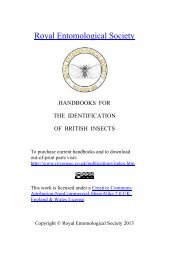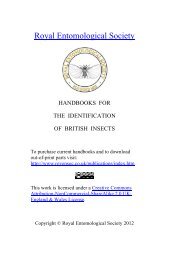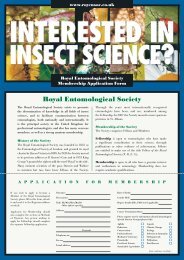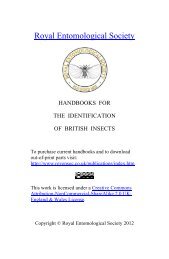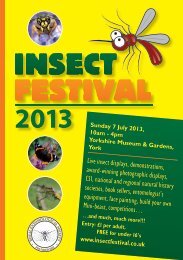Vol 10 Part 14. An introduction to the immature stages of British Flies ...
Vol 10 Part 14. An introduction to the immature stages of British Flies ...
Vol 10 Part 14. An introduction to the immature stages of British Flies ...
You also want an ePaper? Increase the reach of your titles
YUMPU automatically turns print PDFs into web optimized ePapers that Google loves.
<strong>to</strong>ge<strong>the</strong>r. P. trivia/is Ea <strong>to</strong>n (figs 37- 38) is a common species, <strong>the</strong> larvae <strong>of</strong> which may be<br />
seen creeping about on <strong>the</strong> surface <strong>of</strong> mud, though <strong>the</strong> mud particles trapped in <strong>the</strong><br />
dorsal setae may render <strong>the</strong>m inconspicuous apart from <strong>the</strong> winding tracks left by<br />
<strong>the</strong>ir movements. The larvae <strong>of</strong> P. trifasciata (Meigen) and P. calcilega Feuerborn are<br />
normally thickly encrusted with lime.<br />
The larva <strong>of</strong> Philosepedon humeralis (Meigen) (fig. 34), <strong>the</strong> only <strong>British</strong> representative<br />
<strong>of</strong> <strong>the</strong> genus, feeds in dead snails (Vaillant, 1961; Smith & Grensted, 1963).<br />
Only three <strong>of</strong> <strong>the</strong> 17 <strong>British</strong> species <strong>of</strong> Telma<strong>to</strong>scopus are known in <strong>the</strong> larval stage;<br />
<strong>the</strong>y should be sought at <strong>the</strong> edges <strong>of</strong> ponds or lakes where <strong>the</strong> ground is moist and<br />
occasionally submerged, though Wi<strong>the</strong>rs (1986) records T. tristis Meigen and T.<br />
advenus Ea<strong>to</strong>n from tree rot-holes.<br />
Jung (1956) keys and describes some Panimerus, Threticus and Cly<strong>to</strong>cerus larvae.<br />
The <strong>immature</strong> <strong>stages</strong> <strong>of</strong> o<strong>the</strong>r <strong>British</strong> genera and species remain undescribed from<br />
native material but Vaillant (1971-1976) should be consulted for descriptions <strong>of</strong> some<br />
and notes on <strong>the</strong> likely habitats in which <strong>to</strong> search for o<strong>the</strong>rs (but frequently under<br />
names differing from <strong>the</strong> <strong>British</strong> Check List).<br />
Trichomyiinae. The larva <strong>of</strong> Trichomyia urbica Curtis, <strong>the</strong> only <strong>British</strong> species, is<br />
found in <strong>the</strong> rotting wood <strong>of</strong> fallen trees where it makes a gallery running in <strong>the</strong><br />
direction <strong>of</strong> <strong>the</strong> grain (Keilin & Tate 1937). The body, unlike that <strong>of</strong> o<strong>the</strong>r Psychodidae,<br />
is devoid <strong>of</strong> long setae and <strong>the</strong> head is strongly chitinized (fig. 40).<br />
Sycoracinae. The larvae <strong>of</strong> this subfamily are associated with fast streams and waterfalls<br />
where <strong>the</strong>y live on rocks in <strong>the</strong> splash zone or near <strong>the</strong> surface. Sycorax silacea<br />
Curtis (fig. 39), <strong>the</strong> only <strong>British</strong> representative <strong>of</strong> <strong>the</strong> subfamily, resembles a small water<br />
louse (Asellus) and is found among mosses or rotting leaves in such situations.<br />
<strong>An</strong> account <strong>of</strong> <strong>the</strong> <strong>British</strong> species <strong>of</strong> Psychodidae, by Mr P. Wi<strong>the</strong>rs, is in press.<br />
Ptychopteridae<br />
(Figs: larva 41 , pupa 1113)<br />
The family Ptychopteridae contains more than 60 world species in three genera. In<br />
~ritain <strong>the</strong> family is represented by only <strong>the</strong> genus Ptychoptera with 7 species <strong>of</strong> which 6<br />
have been described in <strong>the</strong> larval stage.<br />
The larva (fig. 41) is very distinctive, with a long, narrow cylindrical body<br />
terminating in a long retractile respira<strong>to</strong>ry siphon. It is whitish-grey in colour,<br />
frequently with a pair <strong>of</strong> brownish eye-spots. The respira<strong>to</strong>ry system is metapneustic.<br />
Small prolegs, each with a single hook-like spine (vh) are present on abdominal segments<br />
1- 3. The presence <strong>of</strong> lateral and median brushes on <strong>the</strong> labrum, and <strong>of</strong> setal<br />
brushes on <strong>the</strong> mandibles (md) and maxillae suggest a detritus feeding habit.<br />
Ptychoptera larvae are semi-aquatic and inhabit saturated mud, or shallow muddy<br />
pools in marshes, Sphagnum pools, or <strong>the</strong> margins <strong>of</strong> streams. Larvae <strong>of</strong> P. contaminata<br />
(L.) prefer mud covered with water and having a high organic content; <strong>the</strong>y are usually<br />
common around farmyard pools and similar situations. P. albimana(F.)is usually found<br />
in mud without a high organic content, e.g. open marshes, thin woodland; P. lacustris<br />
Meigen and P. pa/udosa Meigen (and P. longicauda Tonnoir teste R.l. Vane-Wright)<br />
occur most frequently in woodland streams, in medium or dense shade; P. scutel/aris<br />
Meigen is restricted <strong>to</strong> acid pools with Sphagnum, <strong>of</strong>ten at high altitudes in upland<br />
marshes; P. minuta Tonnoir has been found in a drainage channel around peaty fields.<br />
Brindle (1962d, 1966) and Hansen (1981) provide keys <strong>to</strong> <strong>the</strong> known <strong>British</strong> larvae<br />
with descriptions and ecological notes and Miall ( 1985) gives some interesting<br />
behavioural notes.<br />
38




